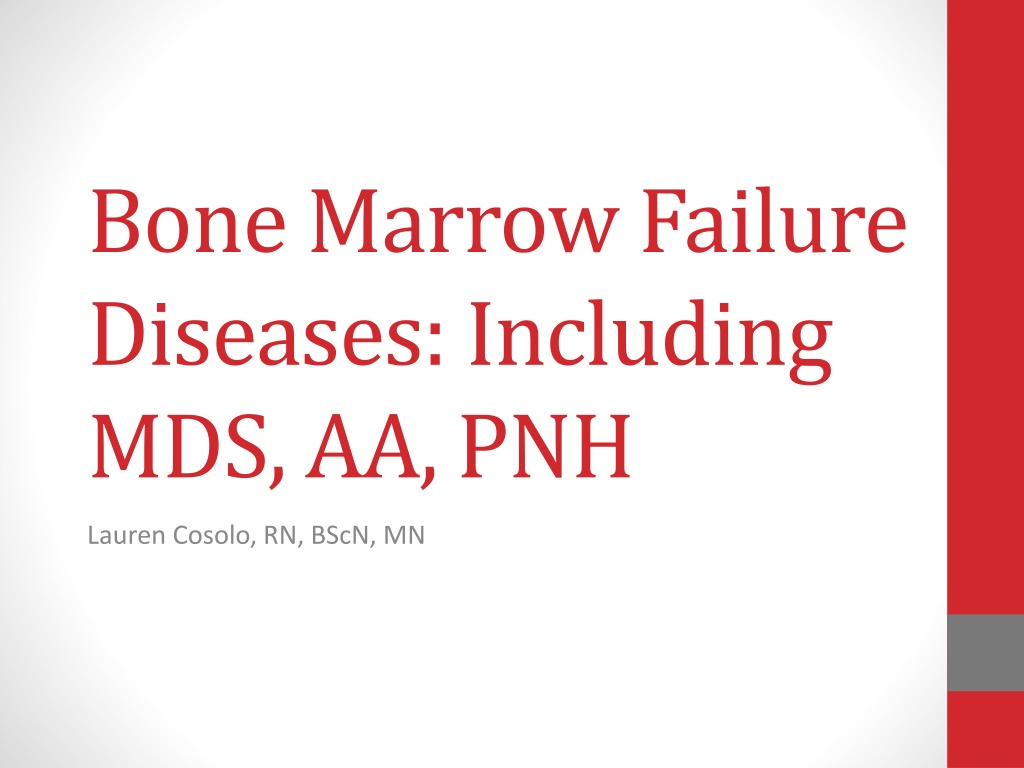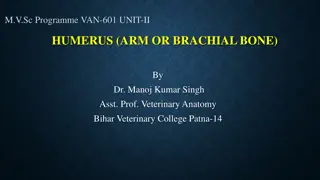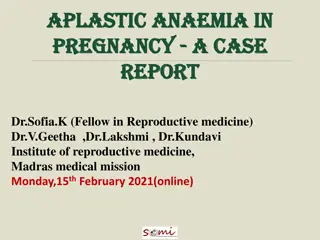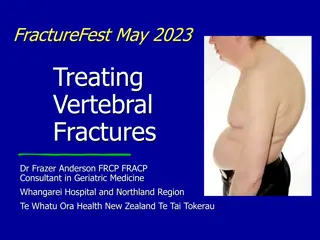Understanding Bone Marrow Failure Diseases: MDS, AA, PNH
Explore the world of bone marrow failure diseases including Myelodysplastic Syndrome (MDS), Aplastic Anemia (AA), and Paroxysmal Nocturnal Hemoglobinuria (PNH). Delve into their pathophysiology, clinical presentations, diagnoses, and treatments, along with nursing considerations. Learn about the ineffective hematopoiesis causing pancytopenia and the impact on blood cell production. Discover the genetic and acquired disorders leading to cytopenia and the clonal disorders affecting hematopoietic stem cells in MDS. Uncover the abnormal regulation of stem cells in MDS due to genetic changes and gene expression alterations.
Download Presentation

Please find below an Image/Link to download the presentation.
The content on the website is provided AS IS for your information and personal use only. It may not be sold, licensed, or shared on other websites without obtaining consent from the author. Download presentation by click this link. If you encounter any issues during the download, it is possible that the publisher has removed the file from their server.
E N D
Presentation Transcript
Bone Marrow Failure Diseases: Including MDS, AA, PNH Lauren Cosolo, RN, BScN, MN
Outline Review bone marrow failure and disease Discuss Myelodysplastic syndrome, pathophysiology, clinical presentation, diagnosis, treatment Discuss Aplastic Anemia, clinical presentation, diagnosis, treatment Discuss PNH, pathophysiology, clinical presentation, diagnosis, treatment Review nursing considerations for bone marrow failure diseases
Bone Marrow Failure Ineffective hematopoiesis causing pancytopenia and the inability to produce healthy blood cells Pancytopenia= reduction in blood counts red cells, white cells, platelets Scheinberg, DeZern, Steensma, 2016; Hoffbrand & Moss, 2016 Image taken from: http://www.lookfordiagnosis.com/mesh_info.php?term=Myeloid+Cells&lang=1
Bone Marrow Failure Diseases Disorders resulting in cytopenia (low blood counts) due to decreased bone marrow production Can be congenital (inherited) or acquired disorders Congenital Acquired Fanconi anemia Diamond Blackfan anemia Dyskeratosis congenita Acquired Aplastic Anemia Myelodysplastic Syndrome (MDS) Paroxysmal Nocturnal Hemoglobinuria (PNH) Young, 2014; Zhang, 2016
Myelodysplastic Syndromes (MDS) Clonal disorders of hematopoietic stem cells characterized by increasing bone marrow failure in association with dysplastic changes (cells look abnormal) in one or more cell lineages Simultaneous proliferation and apoptosis of hematopoietic cells (ineffective hematopoiesis) leading to hypercellular bone marrow but pancytopenia in peripheral blood Pathologyoutline.com
Pathophysiology of MDS There is an abnormal regulation of proliferation, maturation and survival of hematopoietic stem cells due to genetic changes A number of genetic changes/mutations are associated with MDS Changes in the expression of genes, such as hypermethylation contributes to the development or progression of MDS Resulting in suppression of gene transcription As the disease progresses, maturation of stem cells are further impaired with increased survival of myeloblasts
Prevalence and Risk Factors MDS usually develops in older adults >60 years old with median age of 72-76 years More common in males than in females MDS relatively common disease 4-7 estimated new cases/100,000 each year Risk Factors: Older age Male Exposure to environmental factors (benzene) Smoking Previous chemotherapy or radiation treatment Buckstein & Wells, 2008
Etiology De novo MDS Treatment-related MDS Idiopathic Environmental exposure Benzene, solvents, agriculture chemicals Smoking Autoimmune disorders Viral illnesses Inherited genetic abnormalities Other benign hematologic diseases Chemotherapeutic agents Radiation therapy Devine, 2013; Aster & Stone, 2018
Clinical Presentation Patients with MDS typically present with peripheral blood cytopenias Patients range from being asymptomatic with an incidental CBC finding to having symptoms and complications related to the previously unrecognized cytopenia Majority of MDS patients present with red cell lineage dysplasia (anemia) Signs and Symptoms include: Fevers, infection from neutropenia Petechiae, ecchymosis, bruising, bleeding from thrombocytopenia Fatigue, SOB, palpitations, weakness, exercise intolerance, dizziness, pale complexion, cognitive impairment as result of anemia
Diagnosis Diagnosis of MDS dependent on: 1. Quantitative changes in blood elements (cytopenias) 2. Evidence of dysplasia in peripheral blood smear and marrow History Signs and symptoms Past medical history + comorbidities Blood transfusion history Prior chemotherapy/radiation treatment Family history Medications Exposure to chemicals Physical Exam Investigating for evidence of cytopenias Integumentary Mucous membranes Bleeding- epistaxis, gum bleeding, hemoptysis, hematuria, prolonged menstruation, melena Fatigue Vital signs Presence of fevers, infections Presence of splenomegaly
Diagnostic Investigations Initial workup for MDS: CBC with blood smear, reticulocyte count, iron TIBC Ferritin, LDH level, EPO level Initial workup to rule out other causes of cytopenia Blood work Peripheral Blood Smear Dysplasia in red and white blood cells and platelets Bone Marrow Biopsy and Aspirate Aspirate will allow to evaluate morphology of hematopoietic precursors and blasts and cytogenetics (Identification of abnormal chromosomes (ie. 5q- del) and for prognosis) Biopsy will show cellularity (usually increased, sometimes hypocellular bone marrow seen in MDS) Findings can suggest clonality and presence of MDS Used especially when dysplasia is minimal and cytogenetics is normal Flow Cytometry
WHO Classification of MDS Subtype Peripheral blood Bone marrow % blasts Refractory anemia Anemia Unilineage erythroid dysplasia (in >10% cells) <5 Refractory neutropenia Neutropenia Unilineage granulocytic dysplasia <5 Refractory thrombocytopenia Thrombocytopenia Unilineage megakaryocytic dysplasia <5 Refractory anemia with ring sideroblasts (RARS) Anemia Unilineage erythroid dysplasia >15% erythroid precursors are ring sideroblasts <5 Refractory cytopenia with multilineage dysplasia (RCMD) Cytopenia Multilineage dysplasia +/- ring sideroblasts <5 Refractory anemia with excess blasts type 1 (RAEB-1) Cytopenia Unilineage or multilineage dysplasia 5-9 Refractory anemia with excess blasts type 2 (RAEB-2) Cytopenia Unilineage or multilineage dysplasia 10-19 MDS associated with isolated del (5q-) Anemia, normal or high platelet count 5q31 deletion, anemia, hypolobulated megakaryocytes <5
IPSS-R Parameter Categories and Associated Scores Cytogenetic risk group Very good Good Intermediate Poor Very poor 0 1 2 3 4 Marrow Blast proportion 2% >2-<5% 5-10% >10% 0 1 2 3 Hemoglobin 10g/dL 8-<10g/dL <8 g/dL 0 1 1.5 0.8 x 109/L <0.8 x 109/L ANC 0 0.5 100 x 109/L 50 - 100 x 109/L Platelet Count <50 x 109/L 0 0.5 1 Risk Category Risk Score Very low 1.5 Tool is only helpful at time of diagnosis Tool is used to estimate life expectancy for NEWLY diagnosed patients with MDS Low >1.5-3 Intermediate >3-4.5 High >4.5-6 Very high >6
Prognosis Factors that predict outcome include: WHO classification Complex karyotype (>3 chromosome abnormalities) Chromosome abnormalities Blast proportion Cytopenias Even low risk MDS has significant morbidity and mortality including transfusion requirements and associated complications Worsening of pancytopenia, acquisition of chromosomal abnormalities, increase in number of blasts are poor prognostic indicators Therapy related MDS is an extremely poor outlook
Treatment Dependent on: Patient s age Performance status Prognostic score WHO classification comorbidities Determine treatment goals with patient and family, including achieving hematologic improvement, reducing transfusion requirements, delaying transformation to leukemia, improving survival and maintaining quality of life Devine, 2013
Low Risk MDS Treatment Options (IPSS Low Risk/Int Risk-1) For patients that are asymptomatic watchful waiting and monitor Q3-6 months Symptomatic Treatment options Medications for anemia (ESA, lenalidomide), neutropenia (antibiotics, GCSF), thrombocytopenia (antifibrinolytics) Immunosuppressive therapy (ATG, Cyclosporine) Supportive Care (transfusion support, iron chelation) Allo-SCT assessment Delayed allo-SCT offers maximal life expectancy as long as transplant occurs before transformation to leukemia Eligibility ultimately decided by transplant center Often SCT is not an option to due to patients older age or comorbidities Mdsclearpath.org
Disease Progression Potential indicators of progression to high risk MDS Worsening cytopenia New cytopenia Appearance of blasts Rising LDH Systemic symptoms (fever, weight loss) Specific evaluation of higher risk MDS Bone marrow aspiration and biopsy Flow cytometry Cytogenetics Mdsclearpath.org
Treatment Options for High Risk MDS Goal of treatment: Change natural history of MDS Defer AML transformation Improve survival for patients with MDS Treatment Options: Hypomethylating agents (azacitidine, decitabine) (usually standard of care, however not a cure for MDS) Chemotherapy Allogeneic Stem Cell Transplant Supportive Care/ Palliative Care Clinical Trial Mdsclearpath.org
Supportive Care All patients should receive supportive care as it is adjunct to chosen therapy Patients with cytopenias and associated symptoms can receive supportive care Transfusion support Red cells or platelets CMV negative Nursing Management: Identify symptoms of anemia, monitor CBC, monitor for fluid overload and advocate for diuretic Assess response to platelet transfusions (platelet refractoriness) and PRBCS (Hgb) Monitor for SE of transfusions Iron overload Mdsclearpath.org
Iron Overload Management Iron Chelation Therapy Deferoxamine SC daily dose of 1,000 2,000 mg (20 40 mg/kg/day) should be administered over 8 24 hours, using a small portable pump capable of providing continuous mini-infusion. SE: allergic reaction, ocular and ototoxicity, cardiac dysfunction pretreatment hearing and visual exam Defersirox Initial dose 20 mg/kg body weight daily, orally, taken on an empty stomach 30 minutes prior to meals. SE: GI hemorrhage, hepatic/renal failure, cytopenias, diarrhea, n/v, abdo pain Deferiprone SE: agranulocytosis Measure ANC, interrupt if ANC <1.5
Impact of MDS on Patients/Families Quality of life is complex, individually defined for patients living with MDS Includes physical, social, emotional, practical and spiritual aspects Aging, comorbidities, fatigue, and uncertain illness trajectory affects the quality of life of patients Oncology nurses are in an appropriate position to monitor the impact of the illness and treatment on patients and their quality of life through systematic assessment, providing appropriate interventions, referrals and ongoing support Thomas, Crisp & Campbell,2012
Aplastic Anemia Pancytopenia (low blood counts) as a result of hypoplasia of bone marrow Can be inherited or acquired, majority are acquired Reduction in number of hematopoietic stem cells and an immune reaction or error in the remaining stem cells causing them to not divide or differentiate appropriately to populate bone marrow Image: Medical-dictionary.thefreedictionary.com; Hoffbrand & Moss, 2016
Prevalence and Etiology Affects primarily children (with children, majority are inherited), young adults or adults >60 More common in people of Asian descent 2-12 new cases/million each year Etiology: Inherited or acquired Most cases are idiopathic Exposure to chemicals, drugs, viruses, radiation, immune diseases Incekol & Ghadimi, 2015; Hoffbrand & Moss, 2016
Clinical Features Present with signs and symptoms of pancytopenia Most frequent symptoms: Bruising Bleeding gums Epistaxis Menorrhagia Symptoms of anemia (Pallor, headache, palpitation, SOB/dyspnea, fatigue, foot swelling) Infections are common and frequently life threatening Incekol & Ghadimi, 2015; Hoffbrand & Moss, 2016
Diagnosis Blood work CBC with diff, B12, folic acid, LFT, LDH, chem panel, coags Pancytopenia early on Bone Marrow Aspirate and Biopsy Bone marrow is profoundly hypocellular, marrow space is composed mostly of fat cells and marrow stroma Flow cytometry To detect coexisting disorders Cytogenetics Rule out MDS and congenital disorders
Classification Severe Very Severe Non-Severe Presence of 2-3 parameters: ANC <0.5 Platelets <20 Reticulocytes <1% ANC <0.2 Not fulfilling severity criteria Chronic needs >3 months
Treatment very severe & severe aplastic anemia stages require treatment as this category has a high mortality rate HCT ( hematopoeitic stem cell therapy) Dependant on age, functional status and availability of donor Immunosuppressive therapy ATG (Antithymocyte globulin) Horse ATG administered IV over 4 days Requires pre-medication with tylenol/ benadryl to decrease infusion reactions and serum sickness reaction Requires daily steroids to reduce risk of serum sickness Risk for anaphylaxis- keep anaphylaxis kit at bedside during infusion Cyclosporine SE: HTN, renal insufficiency, Mg deficiency, gum hyperplasia Requires BP, Cr monitoring, regular dental care Larratt, powerpoint; Longo, 2017
Serum Sickness Occurs 1-2 weeks after initiating treatment of ATG Flu-like illness, rash and arthralgia Treatment: steroids
Supportive Care Transfusions RBC, platelets Irradiated Blood Treatment of Infections Empiric therapy with broad spectrum antibiotics Growth factors as prophylaxis for repeated infections Infection Prevention and Monitoring Patient education on preventing infections and monitoring for fever and signs and symptoms of infection
Paroxysmal Nocturnal Hemoglobinuria (PNH) Acquired hemolytic anemia Characterized by: Hemolysis Venous Thrombosis Pancytopenia Longo, 2017
Pathophysiology Acquired mutation in PIG-A gene in hematopoietic stem cell If mutation proliferates the result is a clone that is deficient in cell surface proteins known as glycosylphospatidylinositol- anchored proteins (GPI-AP) The GPI-AP proteins act as receptors, complement regulators and adhesion molecules CD55 and CD59 which are two GPI-AP that protect red blood cells from complement activity are not present on the surface of the PNH red blood cells, which leaves these cells extremely sensitive to complement-mediated destruction Young et al., 2009
Prevalence Same frequency in men and women Rare disease Prevalence estimated at 5/1,000,000 Can present in small children or older adults, most patients are young adults
Clinical Presentation Anemia Results from a combo of hemolysis and bone marrow failure Thrombosis Common sites: intraabdominal( hepatic, portal, mesenteric, splenic) and cerebral veins with hepatic vein thrombosis (Budd-Chiari syndrome) Gastrointestinal Abdominal pain, esophageal spasm, dysphagia Other Manifestations Gross hemoglobinuria, renal tubular damage Brodsky, 2014
Diagnosis Blood work CBC with diff Liver profile, bilirubin LDH Reticulocyte count Urinalysis Hemoglobinuria Flow Cytometry Identify the GPI-AP deficient peripheral blood cells Parker et al., 2005
Treatment Supportive Care Transfusions Folic acid/iron supplements Treatment of complications (eg. Thrombosis) Biotherapy Ecullizumab (Solaris) Allogenic SCT for young patient with severe PNH Primary prophylaxis for thrombosis Longo, 2017
Nursing Considerations for Bone Marrow Failure Diseases Comprehensive assessment of patient and management of side effects Monitoring for signs and symptoms of cytopenias including fatigue, bleeding, infection, etc. and providing appropriate interventions Addressing patient s supportive care needs Education for patients and families on understanding the disease and its manifestations, treatment modalities and the adverse effects from treatment Connect to hospital and community resources
AAMAC Telephone and e-mail patient-to-patient support Educational material on Aplastic Anemia, MDS & PNH Quarterly newsletter Patient Tracker Local support group meetings Grants for medical research and education Website, Facebook, Marrowforums http://www.aamac.ca/
References Devine, H. (2013). Myelodysplastic syndromes. In M. Olsen & L. Zitella (Eds.), Hematologic Malignancies in Adults (51-74). Pittsburgh, Pennsylvania: Oncology Nursing Society. Buckstein, R. & Wells, R. (2008). Myelodysplastic syndromes (MDS). Retrieved from: https://sunnybrook.ca/uploads/Myelodysplastic_Syndromes.pdf Burgoyne, T. & Knight, A. (2000). Myelodysplastic syndromes. In M. Grundy (Ed.), Nursing in Hematological Oncology (21-30). London, UK: Baillere Tindall Royal College of Nursing Celgene. (2010). Vidaza azacitidine for injection. Thomas, M.L., Crisp, M., & Campbell, K. (2012). The importance of quality of life for patients living with myelodysplastic syndrome. Clinical Journal of Oncology Nursing, 16(3), 47-57 Van de Loosdrecht, A. A., & Westers, T. M. (2014). Flow Cytometric Immunophenotyping in Myelodysplasia: Discovery and Diagnosis. Blood, 124(21), SCI-24. Accessed June 24, 2018. Retrieved from http://www.bloodjournal.org/content/124/21/SCI-24. Incekol, D. & Ghadimi, L. (2015). Princess Margaret cancer centre: malignant hematology: self-learning booklet. 3rd edition. Longo, D.L. (2017). Harrison s hematology and oncology. New York: McGraw-Hill Education Brodsky, R. A. (2014). Paroxysmal nocturnal hemoglobinuria. Blood, 124, 2804-2811 Parker, C. et al. (2005). Diagnosis and management of paroxysmal nocturnal hemoglobinuria. Blood, 106, 3699-3709 Young, N.S. et al. (2009). The management of paroxysmal nocturnal hemoglobinuria: recent advance in diagnosis and treatment and new hope for patients. Seminars in Hematology, 46(1), S1-S6
References Hoffbrand, A.V. & Moss, P. A.H. (2016). Hoffbrand s Essential Haematology. West Sussex, UK: Wiley & Sons, Ltd. MDS Clear Path. Mdsclearpath.org Scheinberg, P., DeZern, A.E. & Steensma, D.P. (2016). Acquired bone marrow failure syndromes: aplastic anemia, paroxysmal hemoglobinuria, and myelodysplastic syndromes. Retrieved from: http://ash- sap.hematologylibrary.org//content/2016/489.extract?utm_source=TrendMD&u tm_medium=cpc&utm_campaign=American_Society_of_Hematology_Self- Assessment_Program_TrendMD_0 Young NS. Young N.S. Young, Neal S.Bone Marrow Failure Syndromes Including Aplastic Anemia and Myelodysplasia. In: Kasper D, Fauci A, Hauser S, Longo D, Jameson J, Loscalzo J. Kasper D, Fauci A, Hauser S, Longo D, Jameson J, Loscalzo J Eds. Dennis Kasper, et al.eds. Harrison's Principles of Internal Medicine, 19e New York, NY: McGraw-Hill; 2014. http://accessmedicine.mhmedical.com/Content.aspx?bookid=1130§ionid=7 9731602. Accessed August 01, 2018. Zhang, L. (2016). Inherited and acquired bone marrow failure syndromes: in the era of deep gene sequencing. Journal of Leukemia, 4(4)























